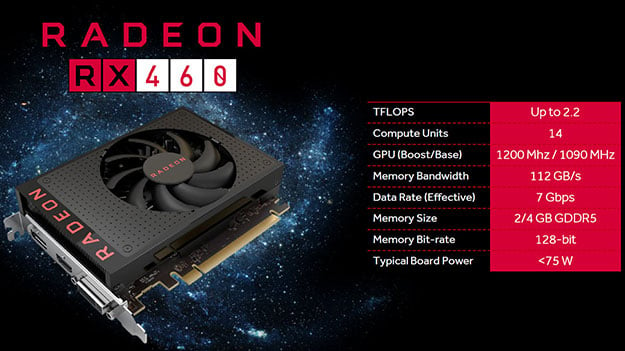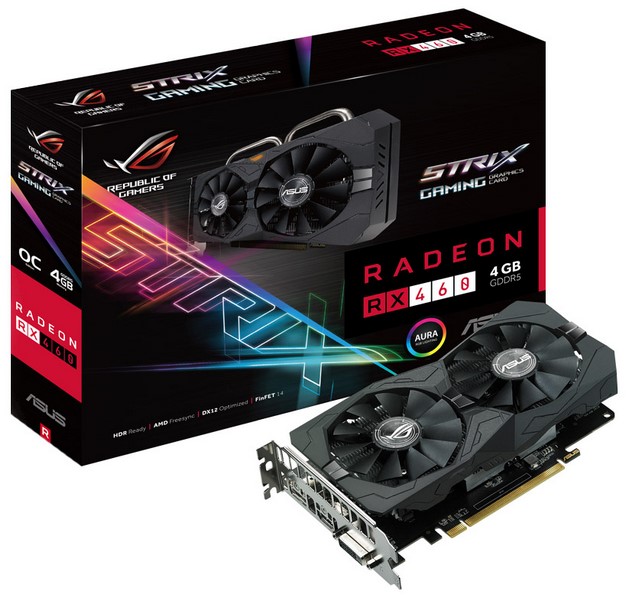AMD Radeon RX 460 Review: Polaris On A Budget
Introducing The Radeon RX 460
AMD and NVIDIA have been launching graphics cards at a rapid clip this summer. In the last three months or so, about ten new desktop GPUs have been launched or announced, targeting virtually all market segments. Thanks to new architectures and more advanced manufacturing processes, this latest generation of GPUs offer far better performance and efficiency than the previous-gen, with much smaller die sizes too. So it makes sense that the big two discrete GPU makers wanted their latest wares on store shelves ASAP.
Today, AMD is ready with an entry-level graphics card featuring its Polaris architecture, the Radeon RX 460. Unlike the Radeon RX 480 and RX 470, the RX 460 is built around a new piece of silicon, the Polaris 11 GPU. The RX 480 and RX 470 feature the larger, more powerful Polaris 10.
|
| Radeon RX 480 | Radeon RX 470 | Radeon RX 460 | |
| Architecture | Polaris 10 XT | Polaris 10 Pro | Polaris 11 |
| Stream Processors | 2304 | 2048 | 896 |
| Compute Units | 36 | 32 | 14 |
| Base Clock | 1120 MHz | 926 MHz | 1090 MHz |
| Boost Clock | 1266 MHz | 1206 MHz | 1200 MHz |
| Memory Interface | 256-bit GDDR5 | 256-bit GDDR5 | 128-bit GDDR5 |
| Memory Bandwidth | 224 GB/s | 211 GB/s | 112 GB/s |
| TDP | 150 watts | 120 watts | 75 watts |
| Peak Compute | 5.8 TFLOPS | 4.9 TFLOPS | 2.2 TFLOPS |
| Process Tech | 14nm FinFET | 14nm FinFET | 14nm FinFET |
| MSRP | $199/$239 (4GB/8GB) | $179+ (4GB) | $109+ (2GB/4GB) |
Unlike the Radeon RX 470 and the higher-end Radeon RX 480, which are both built around the Polaris 10 GPU, the RX 460's powerplant is the smaller, Polaris 11. Polaris 11 has somewhat less than the half the resources of a fully equipped Polaris 10 and it is built using the same 14nm FinFET manufacturing process. There are 896 stream processors active in the RX 460, and it has base and boost clocks of 1090 MHz and 1200 MHz, respectively. The end result brings peak compute performance to approximately 2.2 TFLOPs. The RX 460's memory (2GB and 4GB versions will be available) is clocked the same as an RX 480, but it is linked to the GPU via a narrower 128-bit interface, which results in a peak of 112GB/s of bandwidth. The RX 460 is designed with a sub-75 watt TDP in mind, so there will be versions without a supplemental power connector, but the ASUS STRIX does require a 6-pin feed.
The PCB used on the ASUS Radeon RX 460 ROG STRIX is relatively tiny; the overall design is only 7.6 x 4.7 x 1.4 inches. The card is outfitted with a single 6-pin power connector, a 4+1 phase power array with premium caps and chokes, and a custom DirectCU II cooler, with dual fans. The heatsink on the card features heat-pipes that make direct contact with the GPU and dual "wing blade" fans are mounted on top. ASUS claims the cooling assembly is up to 3x quieter and offers 105% more air pressure than reference models, which results in up to 30% lower temperatures. Our equipment isn't sensitive enough to confirm the noise output claims, but we can say that this card is very quiet and GPU temps are a non-issue as well. More on that later, though.
Like its big brother, the RX 460 STRIX has a built-in, GPU controlled 4-pin fan header. Should you want to add additional GPU cooling and have it controlled by GPU temperatures, rather than CPU or case temperatures like most motherboard-mounted fan headers, it can be plugged right into the card and tweaked in ASUS' software.
The ASUS Radeon RX 460 ROG STRIX features customizable RGB lighting as well. Using the included Aura utility, the color of the ROG logo on the top edge of the card can be set to virtually any color. It offers different modes of operation too -- the lighting can be tuned to change color in line with GPU temperatures, cycle through different colors, or pulse on an off.
The display configuration on the ASUS Radeon RX 460 ROG STRIX consist of a Dual-Link DVI-D output, one HDMI 2.0 output, and one DisplayPort 1.4 output. All three of the outputs can be used simultaneously and the maximum supported resolution is 5120x2880.
ASUS includes a few bundled items with the Radeon RX 460 ROG STRIX as well. Along with the card itself, ASUS throws in some ROG-branded cable ties and some orange colored decals, should you want to add some color to the card. There's also a basic lit pack and a driver / utility disc, which includes copies of ASUS' GPU Tweak II and the Aura utility for controlling the RGB lighting on the card.
Many of AMD's other board partners are at the ready with RX 460 card as well. Above we have some pictures Radeon RX 460s from XFX (top), PowerColor (left), and Gigabyte (right). There are some interesting things to note in these images. First, the PowerColor and Gigabyte cards are only 2GB. Also notice the edge connector on the Gigabyte card -- it only has a PCI Express x8 connection. That shouldn't affect overall performance with a card like the RX 460, however.












